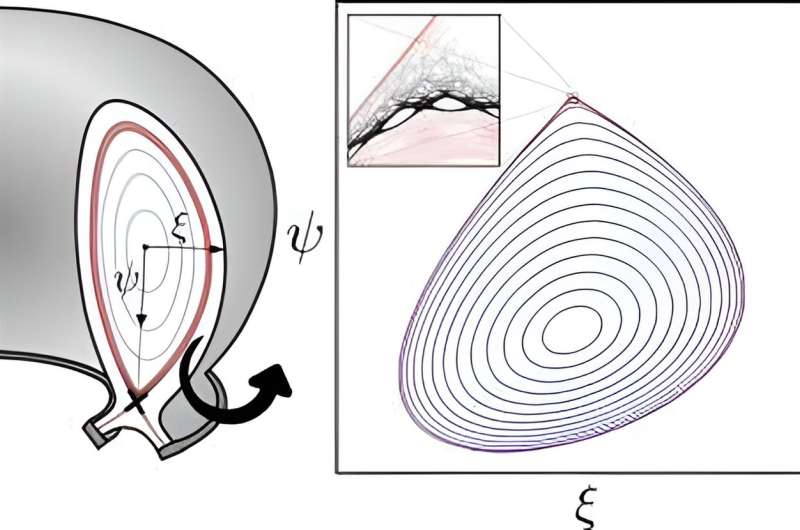Schematics of a poloidal section of a divertor tokamak, showing the closed magnetic field lines (light blue), the region around the magnetic separatrix (gray region between the red lines), magnetic saddle (black cross) and the general rectangular coordinates. Credit: Fundamental Plasma Physics (2023). DOI: 10.1016/j.fpp.2023.100027
Tokamaks are one of the most widely studied technologies in the global effort to achieve sustained nuclear fusion. Using intense magnetic fields, they confine superheated plasma within their doughnut-shaped interiors, allowing atomic nuclei to fuse together and release vast amounts of energy.
If this plasma is confined tightly enough, the process will release more than enough energy to keep the fusion reaction going indefinitely.
One of the main challenges with this approach stems from small deviations that occur in the plasma's motion, driven by factors such as imperfections in the tokamak's magnetic field coils or fluctuations in the plasma's temperature. To correct for these disruptions, it is vital for operators to quantify these deviations as accurately as possible.
In an analysis published in Fundamental Plasma Physics, Matheus Palmero and Iberê Caldas at the University of Sao Paulo, Brazil, present an investigation into the characteristics of this intermittent plasma behavior.
Their work provides fresh insights into the different factors affecting plasma evolution as it deviates from its expected motion. Incorporating these theories into practical tokamak operation could be a promising next step towards the long-awaited goal of sustained nuclear fusion.
Within a tokamak, fluctuating plasma can be best described by a "mixed phase space": where chaos coexists with regular motion. In their paper, Palmero and Caldas present two numerical investigations into the characteristics of mixed phase space, which account for the magnetic fields used to confine the plasma.
Their first approach identifies repeating patterns in groups of chaotic plasma trajectories, and uses them to find magnetic field lines generated by the plasma which vary significantly from their usual arrangement. The second focuses on the short-lived dynamics of these field lines moments before they escape from the tokamak.
By offering deeper insights into tokamak plasma evolution, the duo hopes that their methods could improve researchers' understanding of how plasma behaves in a mixed phase space. In turn, they could eventually lead to advanced new techniques for confining plasma more effectively.
More information: Matheus S. Palmero et al, Confining and escaping magnetic field lines in tokamaks: Analysis via symplectic maps, Fundamental Plasma Physics (2023). DOI: 10.1016/j.fpp.2023.100027
Provided by SciencePOD
























